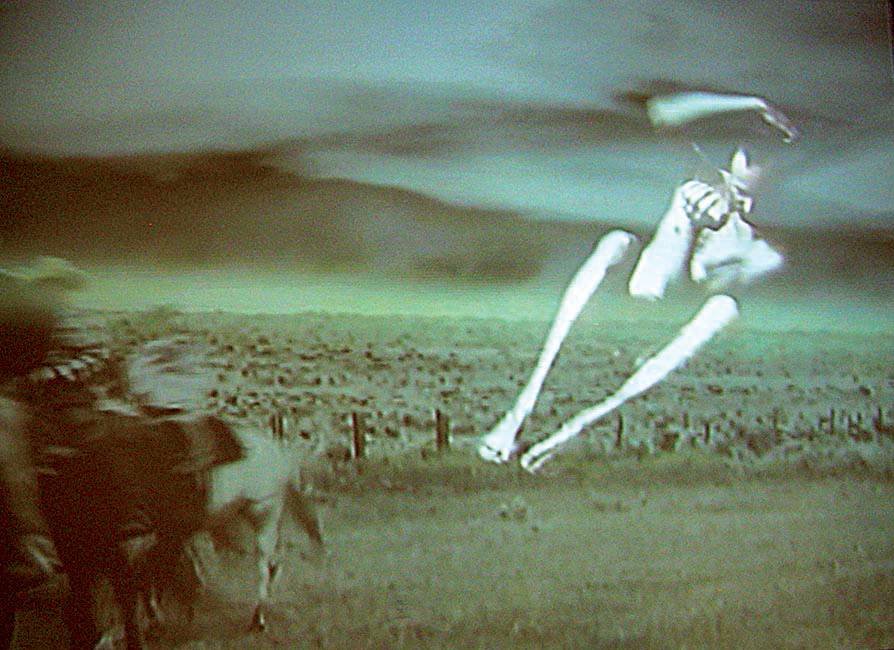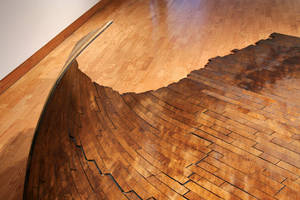Installation art can be defined as the use of various media to modify a particular space in order to create a visceral and/or conceptual experience. A genre that became popular in the 1970s, it has become the Holy Grail for many artists seeking their bona fides as cutting-edge artists. The genre has become so protean that artists as fundamentally different as Robin Starbuck and Brent Sommerhauser can both try their hand at it, but achieving an installation that works may be harder than they thought.
Starbuck’s installation, Intention to Leave, has four elements, but only two really count—a video and an unusual soundtrack. Faux wall graphs which are supposed to represent sound waves and mountain silhouettes are ugly and superfluous, and bales of hay for seating don’t really transform the space. The video is projected in a darkened room on a screen that fills an entire wall of the gallery. It begins with a bird’s-eye view of a naked man curled into a fetal position followed by a feather, each slowly rotating and traveling across the screen accompanied by the faint lowing of cattle. The scene changes to a cattle roundup, and the soundtrack segues into Buddhist chants, which sound very much like Native American ones. These continue through repeated close-ups of cowpokes branding calves and castrating bulls with a matter-of-fact brutality. What are disturbing images to city slickers like me, not inured to the realities of ranching, are ameliorated by the dreamlike quality of the video, which is drained of color and almost imperceptibly slowed down. The chants lulled me into watching scenes I might ordinarily turn away from. As the cows returned to pasture a hint of color could be discerned.
More
- Intention to Leave
- Through July 17
- Charleston Heights Art Center, 800 S. Brush St. 229-6383
- The bottom line: ***
- Amidst: An Exhibition of Recent Coercions
- Through July 25
- Donna Beam Fine Art Gallery, UNLV. 895-3893
- The bottom line: ***
How these things are connected is open to conjecture, but the experience had a visceral effect on me. It was cathartic and calming. The wall text explains that the chants when repeated 12 times are supposed to be healing. I believe it. Starbuck’s installation is really video art masquerading as installation art, but it works on a primal level through the odd juxtaposition of images and sounds.
Visiting Sommerhauser’s Amidst: An Exhibition of Recent Coercions was a totally different experience. I felt challenged to sort through the different media and Sommerhauser’s intricate explanations to find my own connection to the work. Trained as a glass blower in the famed studio of Dale Chihuly, he learned early on that what seems solid and stable can be bent. With great skill he’s been bending materials ever since, often into his signature cresting wave form. Probably the most labor-intensive piece in the show is a tongue-in-groove flooring the size of my living room, impressively curled in one corner into his favorite wave shape.
A wedge is another shape that fascinates him. “A simple tool that amplifies force,” it appears throughout the exhibit carved in wood, molded in glass and in a pencil drawing of two wedges side by side—his homage to Albrecht Dürer’s famous “Praying Hands.” Tacked casually at the top, one of the bottom corners curls up, combining these two shapes—the wave and wedge—and making a clever connection between a man-made tool and a spiritual tool for getting God’s help.
At the opening reception a prayer may have been needed to keep upright a five feet-plus column made of 8 ½ x 11-inch copy paper. Nothing was holding it up save the artist’s diligence, checking and adjusting for perfect verticality with a straight-edged ruler every time he added a ream of paper to the stack. But that is only half of Sommerhauser’s mind game. The other half is an overhead speaker playing a recording of paper flapping in the wind. “If you take what you hear to be true,” he says, “you expect the paper to blow away; if you take what you see to be true, you expect the paper to stand.” His message is you can’t always trust your senses, and he was hoisted by his own petard, admitting that every once in a while he looked for an open door while assembling the piece.
Sommerhauser believes that by coercing stubborn materials into submission and questioning your senses you can imagine the unimaginable and believe the unbelievable. His individual works have a lyrical quality I love, but the installation is too cerebral, requiring arcane knowledge that doesn’t allow for a transformative experience. Still, this may be a little unfair: I saw the show as it was being installed by the artist, which made quiet contemplation impossible.


Previous Discussion: